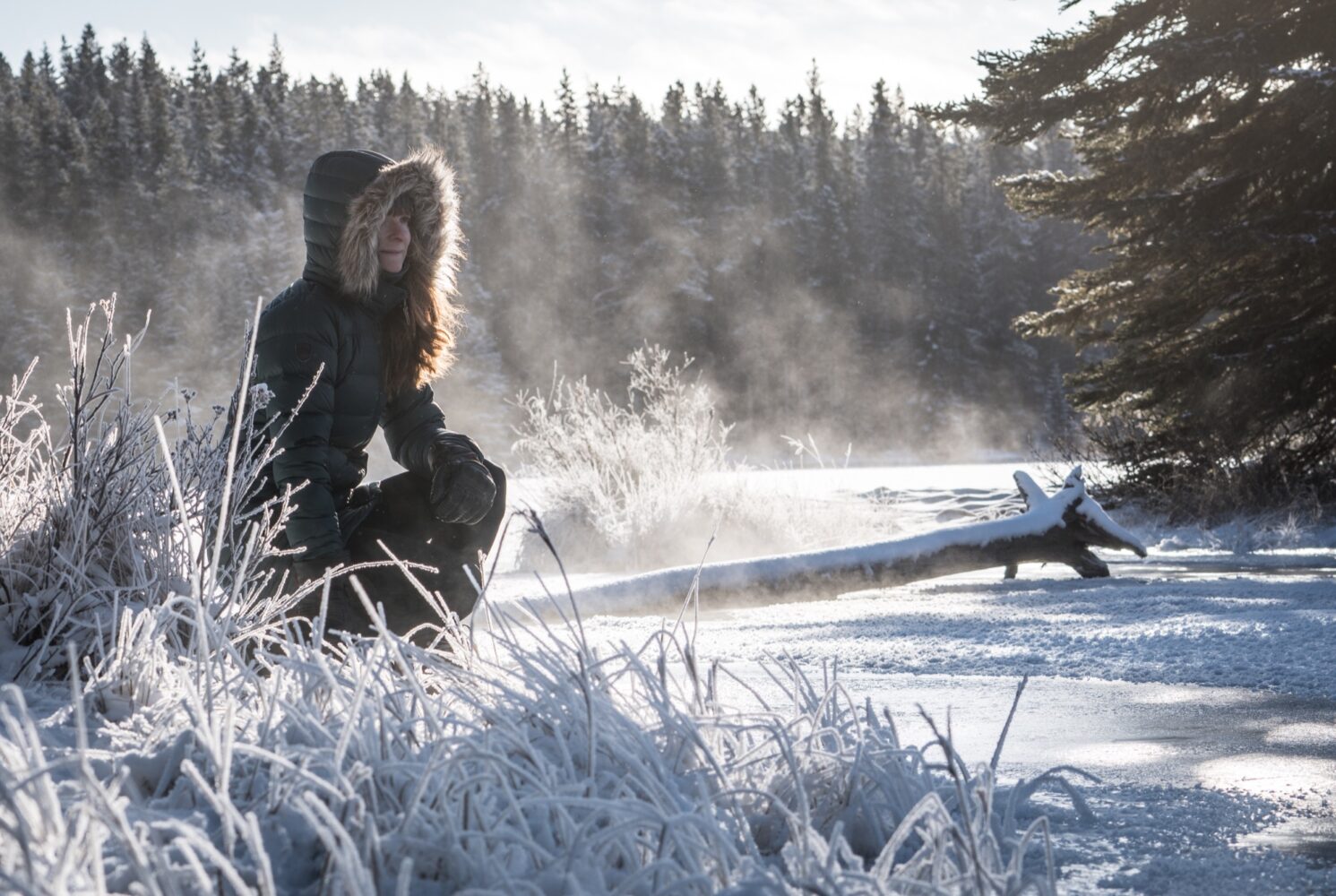Words by Lisa Morris, photography by Jason Spafford.
I don’t know about you, but the excitement of seeing the first snowflakes settle fills me with a purity of spirit. Especially when everything gleams white in graceful silence, leaving behind a grey and dreary world for a fresh and sleek one. Snow and frost transform the landscape’s tonality into a fairytale-like sanctuary. Hues become simplified as snow softens the stronger tones and highlights the otherwise less-prominent pastels. So, how does one seize that glittering winter wonderland? Here are a few tips and techniques to help you capture those brilliant white opportunities, bestowing a backdrop of unfettered joy sparkling in the sun.
S-mitten: Love at Frost Sight
You awake to a sky that’s bequeathed a bounty of snow, and all you can think about is running outside to start shooting. Conditions are compelling, but it’s no laughing matter in rude temperatures if you forget to don the trap-the-air-to-your-body layers: merino wool against skin, fleecy mid-layers, and down insulation underneath a waterproof shell. Complete that ensemble with thermal, waterproof boots, thick mittens with detachable fingertips, and hand warmers for next-level comfort.

Equipment: Licence to Chill
As crucial as maintaining body warmth, keep spare, charged-up batteries close to your body (or hand warmers) to save them from depleting quickly when used in the cold. It’s a snow-brainer.
Stow several microfibre cloths in your bag for wiping condensing lenses.
Grab a lens hood to avoid lens flare and light leaks springing from highly reflective snow.
A polarising filter can be employed to darken a bright, cloudless sky and prevent unwanted blurs or reflections. A UV or clear filter will protect the front element of your lens from moisture.

A zoom lens offers a variety of focal lengths without compromising your arsenal.
When your camera’s out but not in use, keep the lens cap on to stop those flakes from melting on your glass.
If the snow falling is wet (e.g., UK British snow), not dry (e.g., Canadian Albertan snow), consider investing in a rain cover (Think Tank or Ruggard) for your DSLR. Ones with drawstring closures and transparent plastic aid photography in the snow. Or, go for the inexpensive approach and pack a golf/fishing umbrella.
Store your camera in a large zip-lock or dry bag so any condensation that emerges upon going indoors can form on the bag instead of your optical equipment.
Settings: Icy What You Did There
Shoot in raw: Shooting the right exposure and colour temperature is tricky when reflective snow predominates the site. Fortunately, raw means you can recover highlights and adjust shadows in post.
Overexposure: Counter-intuitive as it sounds, in bright snowy conditions, you need to overexpose the image to compensate for your camera’s metering system, which is calibrated for middle grey with a tendency to underexpose to create a balanced image. Experiment by bumping up one to two f-stops.


Histogram: Forget the LCD screen; the histogram readout more accurately reflects what’s happening with the dynamic range of tones and thus exposure.
Keep your balance: Alas, the wrong white balance will throw off the entire tone of your picture. A slight blue cast with neutral highlights results in a balanced image, but feel free to set your white balance (e.g., cloudy white balance around 6,500 kelvin) to ignite shots with a warmer, moody, or stark feel.
Stay Composed: Snow Matter What
Ensure your footprints are not in the frame to blemish that pristine aura you wish to shoot.
A fresh snowfall will set up your composition (cue an early start), where expanses of white are brought to life by the pop of contrast. Namely, focus on someone’s coat, bag, or sledge; for example, in vibrant shades such as red, yellow, pink, and orange. That said, shooting a monochromatic image can be just as striking and engender an expressive pencil drawing.
When the white stuff is falling, a faster shutter speed (e.g., 1/250th second) will freeze the action, highlighting the snowfall over the locale. Conversely, a slower shutter speed will produce long white blizzard-like streaks or erase the snowflakes altogether—your preference.

Becoming subjects cloaked in white include a lone tree, pine forest, mountaintops against a low sun, and a cherry-glow sky of warm and cool tones. Practically anything during golden hour and blue hour when the air becomes cooler and therefore clearer; ice crystals in the air cause the light to diffract, and set the colours to brilliant. When you expose for the sky, all else darkens into a mysterious drama.
Snow bokeh: a fast lens, wide aperture (f/1.2-f/1.8), and fast shutter speed will seize the snowflakes into quite the decorative freeze-frame.
Shoot from varying perspectives: encapsulate the way snow blankets the ground, meringues the landscape in soft white peaks, buries the ordinary in soft shapes, and clings to everything beautifully.
Possessing the patience of Mother Teresa will pay off. Light changes fast, and although it may be sub-zero, sunshine and shadows add a crisp aesthetic and intrigue to any snow scene worth its weight in white.
Make Snow Bones About It
Shooting snowscapes—while taxing on the extremities and equipment—is worth every frost-bitten hardship endured. Yielding dreamlike images of a snowfall is an attainable endeavour no matter your skill level, inspiring warm thoughts of cold climes. Just dress you and your camera for the weather, keep your cool for the right conditions, and you’ll be snow happy in no time at all.

Our No Compromise Clause: We carefully screen all contributors to make sure they are independent and impartial. We never have and never will accept advertorial, and we do not allow advertising to influence our product or destination reviews.


